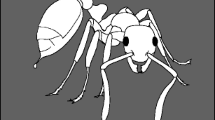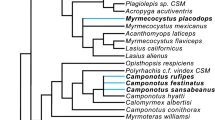Abstract.
Both monogyne and polygyne colonies of Solenopsis invicta now occupy Taiwan. Although venom alkaloids of these ants have been described and synthesized, we here report on a quantitative analysis of the two social forms for the first time. The alkaloids were studied by gas chromatography coupled to mass spectrometry (GC-MS), and six major venom alkaloids were detectable in both types of workers. Both C13:C13:1 and C15:C15:1 ratios in alkaloid venom of monogyne workers were statistically higher than that of polygyne workers, but the sum of proportions of unsaturated alkaloids of polygyne workers was significantly higher than that of monogyne workers, regardless of growth temperature, sampling seasons or geographic location. Results of this study demonstrate that the difference in the proportions of unsaturated alkaloids and the ratios of C13:C13:1 and C15:C15:1 alkaloids might be a good indicator for differentiating monogyne and polygyne forms of S. invicta.
Similar content being viewed by others
Author information
Authors and Affiliations
Corresponding author
Additional information
Received 20 February 2008; revised 4 July 2008; accepted 5 August 2008.
Rights and permissions
About this article
Cite this article
Lai, LC., Huang, RN. & Wu, WJ. Venom alkaloids of monogyne and polygyne forms of the red imported fire ant, Solenopsis invicta, in Taiwan. Insect. Soc. 55, 443–449 (2008). https://doi.org/10.1007/s00040-008-1025-2
Published:
Issue Date:
DOI: https://doi.org/10.1007/s00040-008-1025-2




